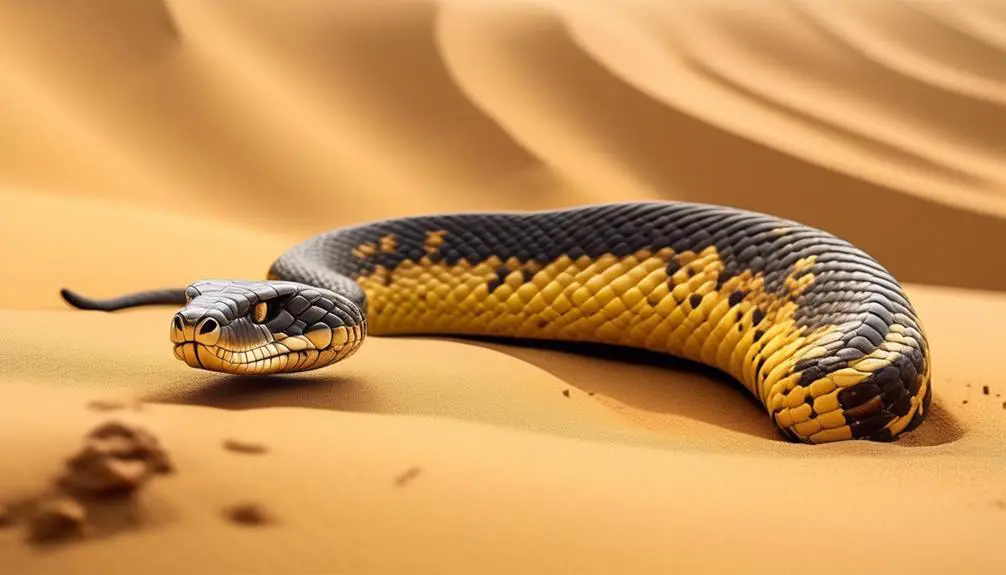Are you aware that Egypt is home to some of the most venomous snakes in the world? These reptiles possess potent venom that can cause serious harm or even death to humans.
From the Egyptian saw-scaled viper, known as the single most venomous snake in Egypt, to the Egyptian cobra associated with Cleopatra’s infamous demise, these snakes demand our attention. With their venom’s deadly combination of neurotoxins, hemotoxins, cytotoxins, and cardiotoxins, their bites can lead to severe consequences.
But fear not, in this article, we will explore the characteristics and distribution of these venomous snakes in Egypt, as well as provide essential facts and precautions to keep in mind when encountering them.
So, let’s dive into the world of Egypt’s most venomous snakes and discover how to stay safe in their presence.
Egyptian Saw-Scaled Viper
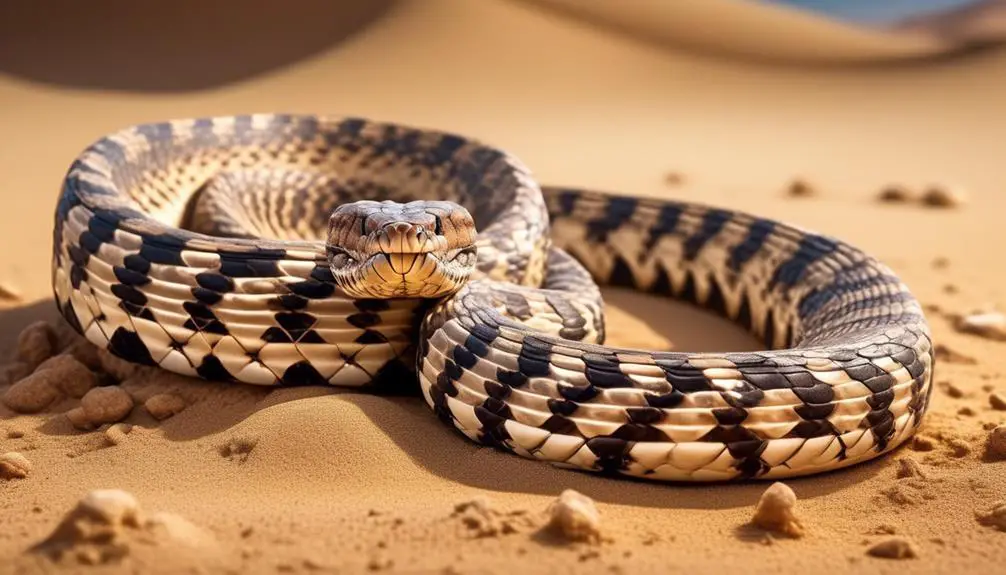
The Egyptian Saw-Scaled Viper, hailed as the single most venomous snake in Egypt, is known for its deadly bite and the high number of snakebite cases it’s responsible for annually.
This snake, also known as the carpet viper or desert carpet viper, can grow between 50cm and one meter in length. It blends in perfectly with the sandy deserts of North Africa, making it difficult to spot and avoid.
The venom of the Egyptian Saw-Scaled Viper is a deadly cocktail that includes neurotoxins, hemotoxins, cytotoxins, and cardiotoxins. This potent combination of toxins can cause severe damage to the nervous system, disrupt blood flow, and lead to organ failure. It’s important to note that female saw-scaled vipers have venom that’s twice as deadly as that of males. The specimens found in North Africa are believed to be deadlier than those found in sub-Saharan Africa.
Due to its highly venomous nature, the Egyptian Saw-Scaled Viper is responsible for a significant number of snakebite cases in Egypt each year. It’s crucial to exercise caution when in areas where this snake is known to inhabit to minimize the risk of a dangerous encounter.
Egyptian Cobra
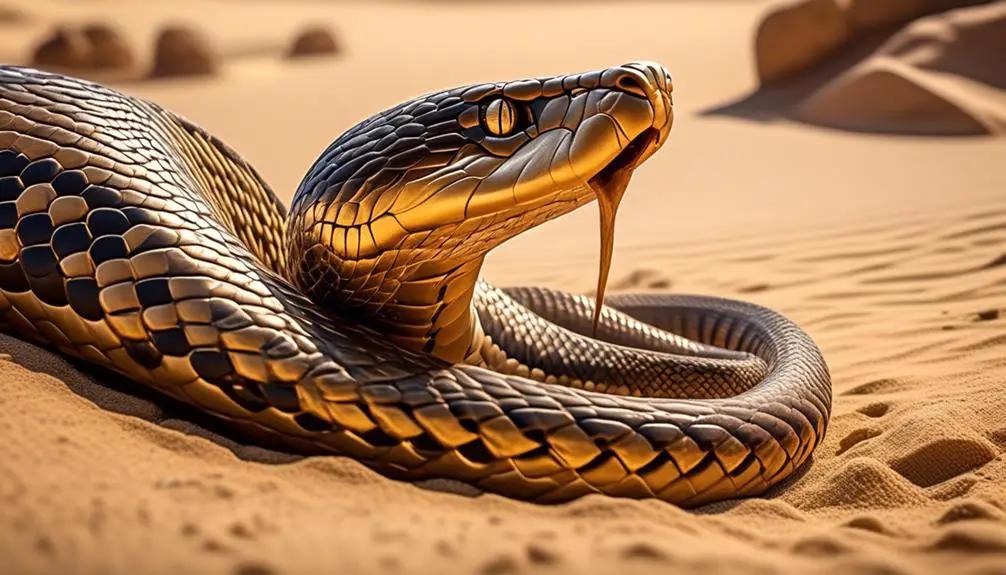
Moving on from the discussion of the Egyptian Saw-Scaled Viper, let’s now explore the fascinating characteristics of the Egyptian Cobra.
The Egyptian cobra, scientifically known as Naja haje, is a venomous snake associated with the fatal bite to Cleopatra. Found across North Africa, including Egypt, this snake poses a significant threat to humans due to its potent venom. The venom of the Egyptian cobra contains cytotoxins and neurotoxins, which can cause severe swelling, necrosis, and even cardiac arrest in victims. It’s important to note that specimens found in sub-Saharan Africa are generally less venomous than their North African counterparts.
The Egyptian cobra, also known as the asp, is a large snake that can reach lengths of up to 2.5 meters. It has a distinctive hood that it expands when threatened, giving it a menacing appearance. Its coloration varies, ranging from yellowish-brown to black, with a lighter underbelly. This allows it to blend in with its surroundings, making it a formidable predator.
When it comes to diet, the Egyptian cobra primarily feeds on small mammals, birds, and reptiles. It’s an ambush predator, relying on its excellent eyesight and venomous bite to incapacitate its prey. Once the prey has been immobilized, the cobra will consume it whole, using its flexible jaws to swallow even larger animals.
Saharan Horned Viper
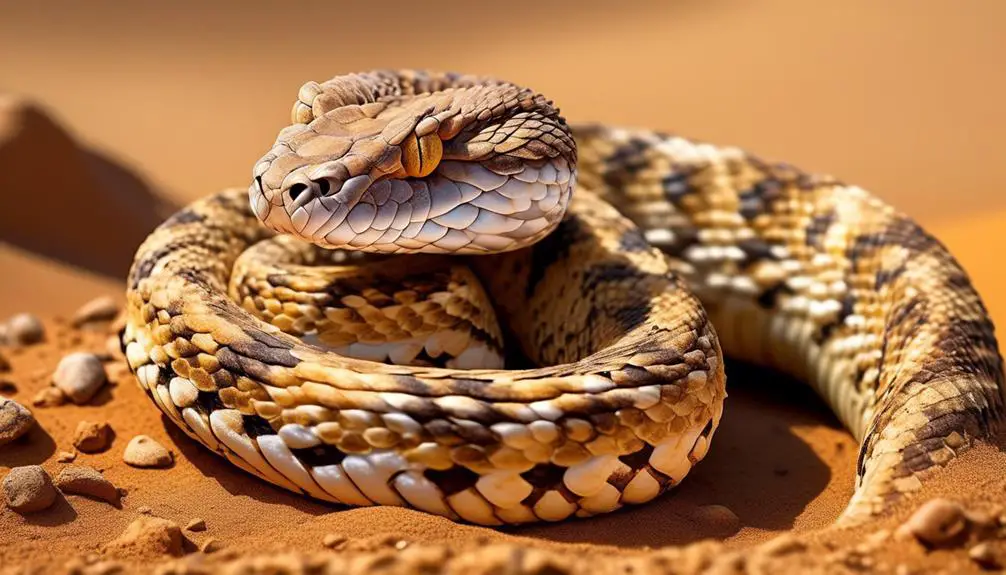
One of the venomous snakes found in Egypt is the Saharan horned viper, a common snake across North Africa that extends from Egypt to Lebanon, Iraq, and Iran. The Saharan horned viper, scientifically known as Cerastes cerastes, is a highly adaptable snake that’s well-suited to survive in sandy environments.
This viper has excellent camouflage, allowing it to blend seamlessly with its surroundings. It possesses a distinct pair of horns on its head, which give it its name. The venom of the Saharan horned viper is a potent cocktail of toxins that can cause issues with blood flow and hemorrhaging. This snake is capable of delivering high venom yields in a single bite, making it a dangerous threat.
It’s important to exercise caution and be aware of your surroundings when in areas where the Saharan horned viper is known to inhabit.
Black Desert Cobra
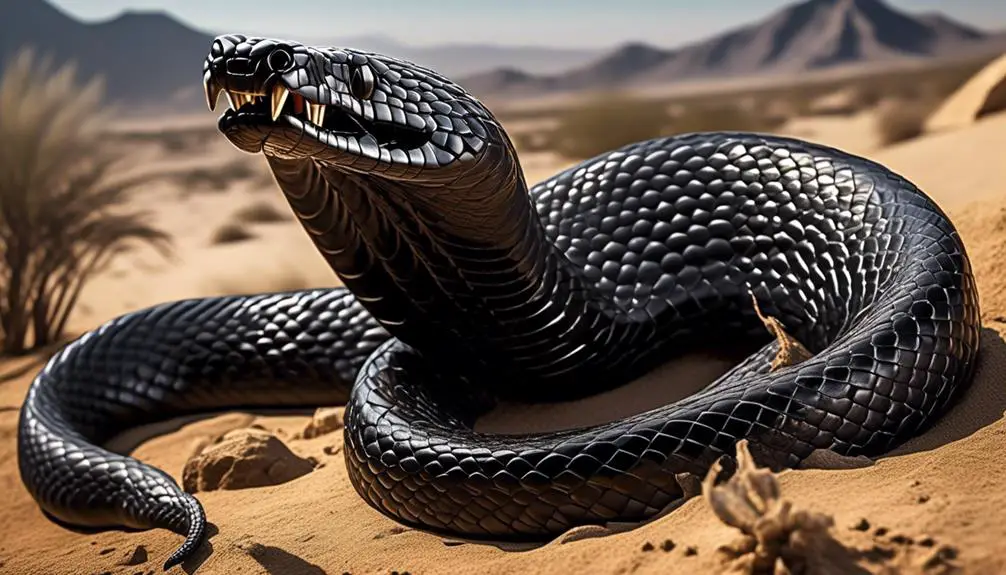
Occasionally encountered in the deserts of the Middle East, the Black Desert Cobra, scientifically known as Walterinnesia aegyptia, is a jet-black and glossy snake that can grow to about 1.2 meters in length. This venomous snake is known for its potent venom, which is more fatal than that of the Indian cobra. When bitten by the Black Desert Cobra, symptoms include disruption of the nervous system, leading to paralysis and potentially death if left untreated.
The Black Desert Cobra primarily inhabits the deserts of the Middle East, including Egypt. It’s a secretive snake that spends most of its time burrowed in the sand or hiding in rocky crevices. Its black coloration helps it blend in with its surroundings, making it difficult to spot.
The venom of the Black Desert Cobra contains a mixture of neurotoxins and cytotoxins, which target the nervous system and cells, respectively. This potent cocktail can cause severe pain, swelling, and tissue damage. It’s important to exercise caution when in the presence of this snake and seek immediate medical attention if bitten.
Although encounters with the Black Desert Cobra are rare, it’s crucial to be aware of its presence and take necessary precautions when venturing into its habitat. Avoiding contact with this venomous snake is the best way to stay safe in the deserts of the Middle East.
Red Spitting Cobra
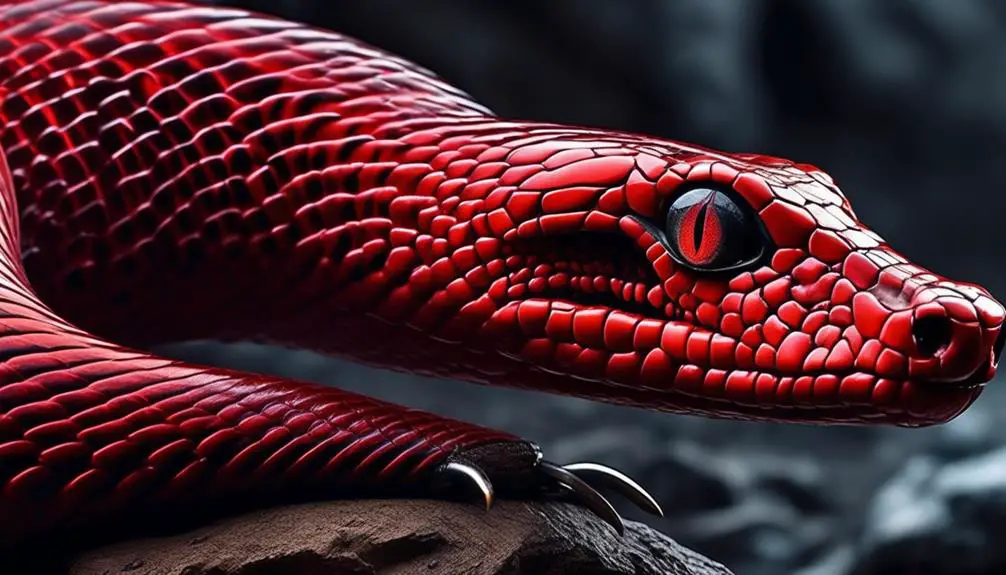
Now let’s turn our attention to the intriguing Red Spitting Cobra, a venomous snake found in Egypt and across East Africa.
This cobra can reach lengths of over 1.2 meters and possesses a unique ability to project its venom at prey from a distance, with a range of up to eight feet.
It’s closely related to other cobra species in Egypt and prefers dry habitats, making it well-adapted to the arid environments of the region.
Venomous Projectile Spit
The Red Spitting Cobra, also known as Naja pallida, possesses a unique and dangerous ability to project its venom at prey from a distance, making it a formidable predator in the snake kingdom. This venomous snake can spit its venom up to eight feet away, targeting the eyes of its victims with deadly accuracy.
The venom of the Red Spitting Cobra is a potent mix of neurotoxins and cytotoxins, which can cause severe pain, tissue damage, and even blindness if it comes into contact with the eyes. This specialized spitting behavior allows the Red Spitting Cobra to incapacitate its prey from a safe distance, ensuring a successful hunt.
It’s important to exercise caution and keep a safe distance when encountering this venomous snake in order to avoid being targeted by its venomous projectile spit.
Distribution and Habitat
The Red Spitting Cobra (Naja pallida) is primarily found across East Africa, extending up to Tanzania, and can be found in dry habitats. This species of cobra is closely related to other cobra species found in Egypt, such as the Egyptian cobra (Naja haje). The Red Spitting Cobra is known for its ability to project venom at its prey from a distance, spitting venom up to eight feet away. This unique adaptation allows the cobra to incapacitate its prey without having to come into direct contact with it. The table below provides a summary of the distribution and habitat of the Red Spitting Cobra:
| Distribution | Habitat |
|---|---|
| East Africa, extending up to Tanzania | Dry habitats |
The Red Spitting Cobra’s preference for dry habitats makes it well adapted to arid environments, such as deserts and savannahs. Its range across East Africa highlights its ability to thrive in various ecosystems within this region. It is important to be aware of the distribution and habitat of the Red Spitting Cobra when venturing into these areas to ensure safety and minimize the risk of encountering this venomous snake.
Characteristics and Distribution
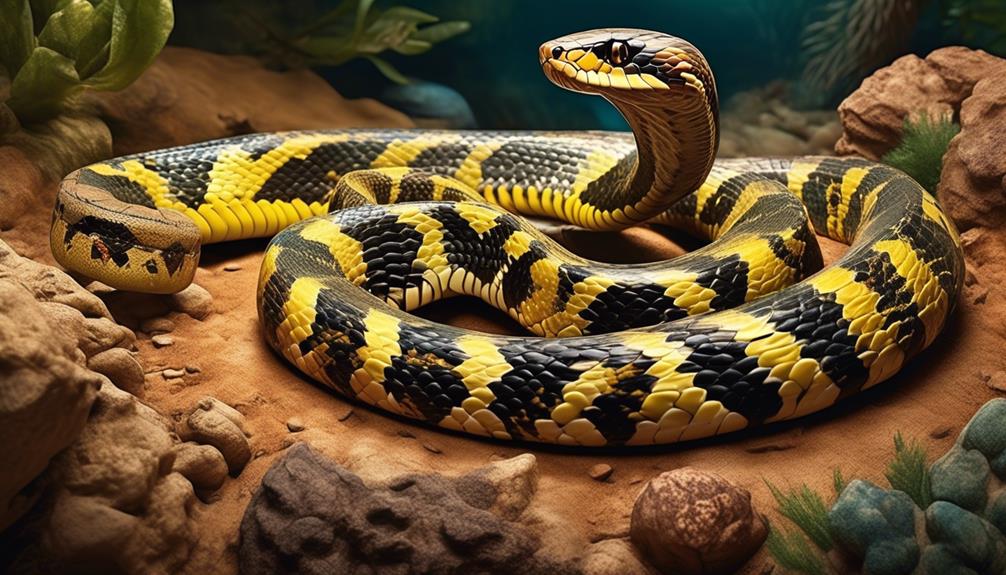
Venomous snakes in Egypt inhabit a variety of habitats, ranging from sandy deserts to dry, arid regions. These snakes are more commonly found in natural environments rather than built-up areas or popular tourist destinations.
The distribution of venomous snakes in Egypt is influenced by factors such as camouflage, prey availability, and the specific adaptations of each species.
Snake Habitats in Egypt
Snake habitats in Egypt exhibit a diverse range of characteristics and distribution throughout the country. Venomous snakes can be found in various regions, although they’re less common in built-up areas like Cairo and Alexandria. They’re also less likely to be found in popular tourist destinations along the Red Sea coast.
The Egyptian saw-scaled viper, known as the carpet viper or desert carpet viper, is considered the most venomous snake in Egypt. It’s frequently found in the sandy deserts of North Africa. Another venomous snake, the Egyptian cobra, is found across North Africa, including Egypt. It’s associated with the fatal bite to Cleopatra.
Other venomous snakes in Egypt, such as the Saharan horned viper, the black desert cobra, and the red spitting cobra, have adapted to sandy environments and prefer dry habitats.
Venomous Snake Distribution
As we explore the distribution of venomous snakes in Egypt, it’s important to understand the unique characteristics and habitats of these deadly reptiles.
Venomous snakes in Egypt are primarily found in regions outside of heavily populated areas like Cairo and Alexandria, as well as popular tourist destinations along the Red Sea coast.
The Egyptian saw-scaled viper, also known as the carpet viper or desert carpet viper, is considered the most venomous snake in Egypt. It can grow between 50cm and one meter in length and blends in with the sandy deserts of North Africa. Its venom cocktail includes neurotoxins, hemotoxins, cytotoxins, and cardiotoxins.
The Egyptian cobra is another venomous snake found across North Africa, including Egypt. Its venom contains cytotoxins and neurotoxins, which can cause severe swelling, necrosis, and cardiac arrest.
Other venomous snakes in Egypt include the Saharan horned viper, the black desert cobra, and the red spitting cobra. These snakes have their own unique distributions and adaptations to their respective habitats.
Facts About the Egyptian Saw-Scaled Viper
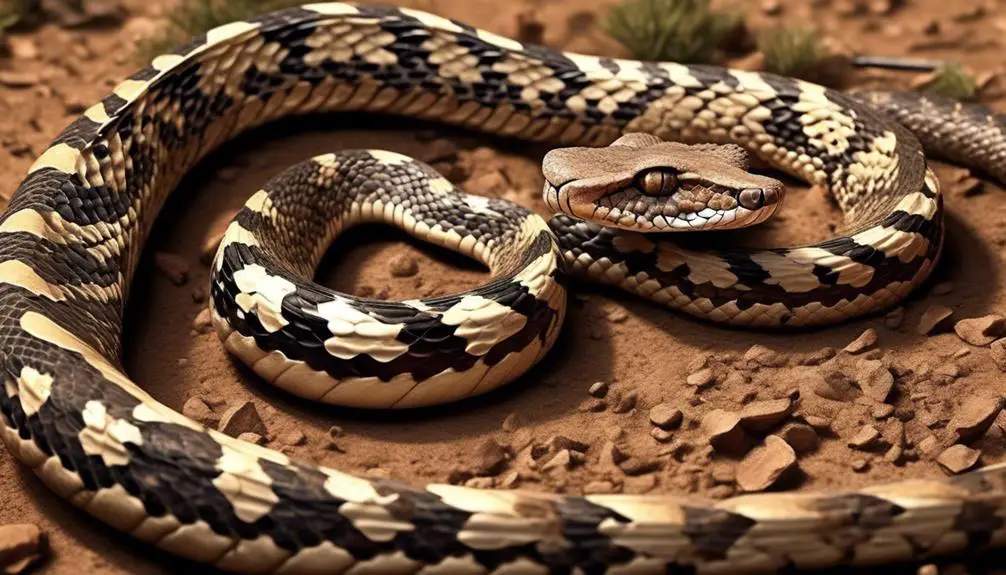
The Egyptian saw-scaled viper, also known as the carpet viper or desert carpet viper, holds the distinction of being the most venomous snake in Egypt. This deadly reptile can grow between 50cm and one meter in length, making it a formidable predator in the sandy deserts of North Africa. Its venom cocktail includes a potent mix of neurotoxins, hemotoxins, cytotoxins, and cardiotoxins, which cause severe damage to the nervous system, blood, cells, and heart. The Egyptian saw-scaled viper is responsible for a high number of snakebite cases annually, posing a significant threat to human populations in the region.
Interestingly, female saw-scaled vipers have venom twice as deadly as males, making them even more dangerous. The specimens found in North Africa are believed to be deadlier than those found in sub-Saharan Africa. These snakes have adapted to their sandy environments with excellent camouflage, allowing them to blend seamlessly with their surroundings and strike unsuspecting prey with deadly precision.
When encountering the Egyptian saw-scaled viper, it’s crucial to exercise extreme caution. Their venomous bite can lead to excruciating pain, tissue damage, and even death if left untreated. It’s always advisable to seek immediate medical attention in the event of a snakebite from this highly venomous species.
Facts About the Egyptian Cobra
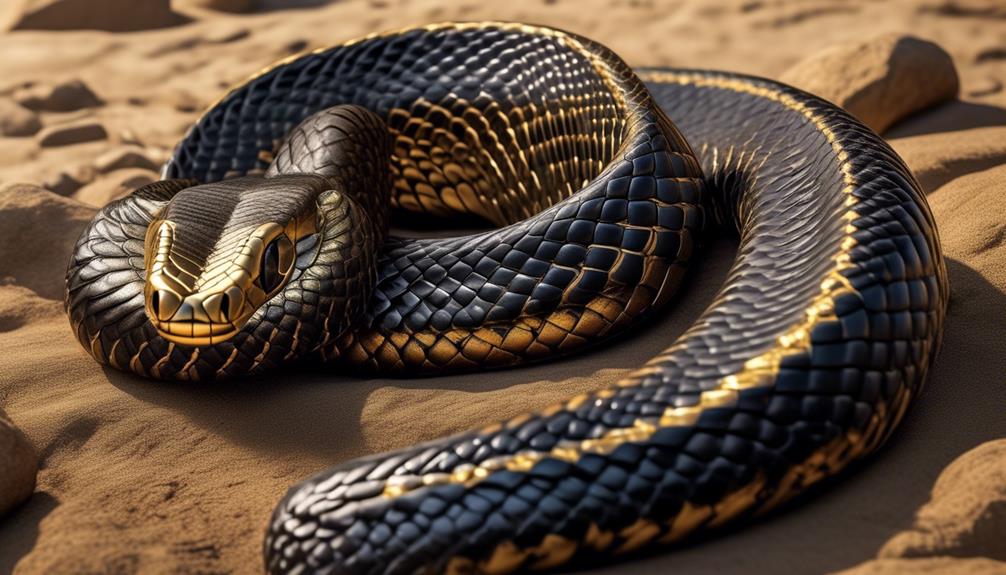
The Egyptian cobra, also known as Naja haje, is a venomous snake found across North Africa, including Egypt. This species is famous for its association with the fatal bite to Cleopatra. The venom of the Egyptian cobra contains cytotoxins and neurotoxins, which can cause severe swelling, necrosis, and even cardiac arrest. It’s important to note that specimens in sub-Saharan Africa are generally less venomous compared to those found in North Africa.
The Egyptian cobra can reach a length of about 2.5 meters, making it one of the largest cobras in Africa. It has a distinctive hood, which it expands when threatened to appear larger and more intimidating. The coloration of the Egyptian cobra can vary, but it’s typically a pale yellow or brown with dark brown or black markings. This helps the snake to blend in with its surroundings, particularly in sandy habitats.
The Egyptian cobra is primarily a diurnal species, meaning it’s most active during the day. It feeds on a variety of prey, including rodents, birds, and other small reptiles. When hunting, it relies on its excellent eyesight and venomous bite to immobilize and kill its prey.

